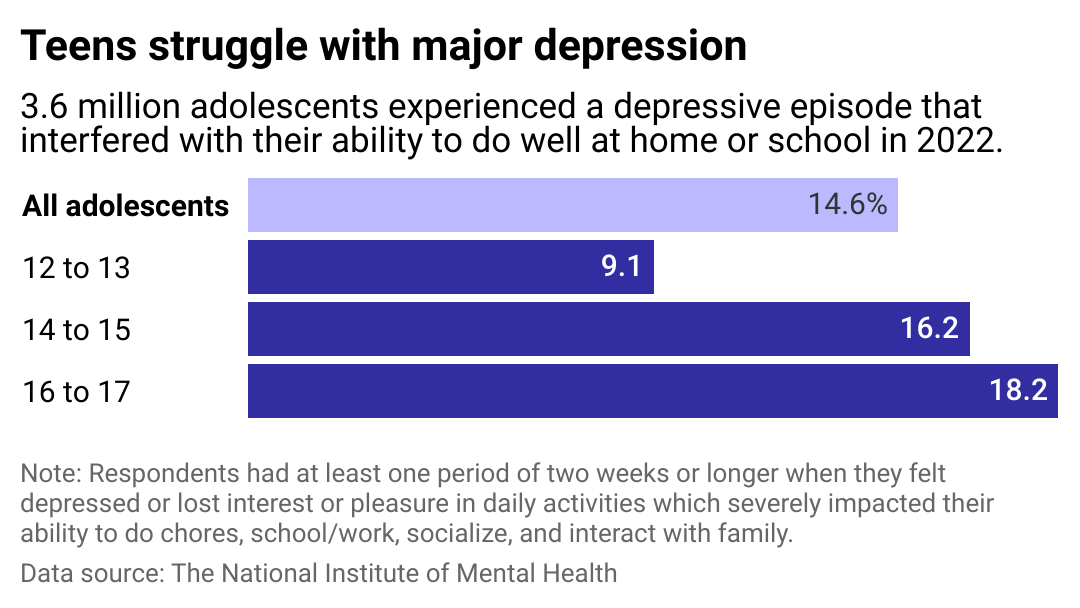Data shows severe depression is most prevalent among teens
Mariana Serdynska // Shutterstock
Data shows severe depression is most prevalent among teens
Teen sitting against a wall with her arms covering her face.
Rates of depression and other severe mental health conditions have become increasingly prevalent among teens—and a modern confluence of factors may be heightening mental health challenges in young people.
The numbers are sobering: In 2021, 4 in 10 students felt persistently sad or hopeless, while 1 in 5 seriously considered attempting suicide, according to the Centers for Disease Control’s most recent Youth Risk Behavior Surveillance Data Summary & Trends. The report also revealed that 1 in 10 youths surveyed attempted suicide.
Teens are not alone in grappling with mental health issues: A 2022 CNN/Kaiser Family Foundation poll found that 90% of adults surveyed in the U.S. feel the country is facing a mental health crisis. However, teens and youth are experiencing rates of depression unlike those seen in the past.
Mental Health Facilities looked at data from the National Survey on Drug Use and Health and other sources to see how severe depression impacts teenagers and what pathways to help and support can be improved.
The 2022 NSDUH report revealed that almost 1 in 5 teenagers—that’s nearly 5 million teens aged 12-17—had a major depressive episode within the past year. An MDE is defined as a consistently depressed mood or loss of interest in daily activities for at least two weeks, often accompanied by issues with eating, sleeping, and concentration.
While there isn’t sufficient data to make direct comparisons, teen depression rates far surpass that of adults. Mental Health America found that almost 9% of U.S. adults (over 22 million people) are affected by major depression each year.
Though some teens experiencing depression do get professional treatment, the NSDUH report found around 40% of those who had an MDE within the past year did not receive mental health treatment during that time. Many adolescents did not seek treatment for depression for a variety of reasons, including the associated costs, concern over what others would think, or because they were unsure how to get help, according to a 2021-2022 Teen National Health Interview Survey.
The grip of depression can be particularly challenging for young people who are still developing their sense of self and may try to mask their feelings. Aidan, a teen who suffered from depression during his 12th grade year, shared with Canadian e-mental health service Kids Help Phone how his external appearance didn’t match how he felt inside. “To everybody in the world, you know, I lacked emotion, I lacked feeling. I couldn’t feel…It was a real disconnect because on the inside, there would be a response but it wouldn’t express itself physically—it wouldn’t come out,” Aidan said.
![]()

Stacker
Teens face a mental health crisis exacerbated by social media, climate change, and COVID-19
A bar shart showing 15% of adolescents had experienced at least one severe depressive episode in 2022. 16 to 17 year olds had the highest rate at nearly 19%.
A growing number of adolescents are living with depression, and research suggests that many of them are also struggling with how to access help. The factors contributing to depression vary from person to person and are typically multifaceted; experts cite a few major factors that are fueling the current decline in teen mental health.
Social media
Rates of teen depression and social media use both rose over the past decade, but establishing a clear cause-and-effect relationship is complex. However, there’s mounting proof that social media does negatively impact young people’s self-esteem. The risk of cyberbullying, sleep disruptions, and the promotion of unhealthy body image and eating behaviors are all negative outcomes associated with social media.
Concerns about social media’s impact on teen mental health have escalated to a public health crisis. The surgeon general released an advisory called Social Media and Youth Mental Health in the spring of 2023, followed in quick succession by the American Psychological Association’s health advisory on adolescents and social media. Both note that while longitudinal scientific research is limited, social media usage in teens can present potential unknown harms.
Climate change
Concern over the increasingly imminent threat of climate change is another major factor contributing to the teen mental health crisis. A 2021 study of 10,000 individuals aged 16-25 in 10 countries also found that 59% of respondents were very or extremely worried about climate change. The full impact of climate change on youth and teen mental health is extremely complex. Adolescents may feel overwhelmed by climate change, powerless to make a difference, and hopeless about the future.
In 2019, Dante Ravenhearst, 20, a researcher and student from Toronto, summed up these feelings for Vice. “When I was doing research at Algonquin Park, I felt immense eco-anxiety…It’s the overall feeling of ‘Wow, I am so honored to experience this, but it’s not going to be here much longer and I’m part of the reason why.’ I feel helpless.”
A 2023 report from the APA found that climate change “poses a particular threat to children and youth.” The report suggests climate change may impact normal cognitive and emotional development in “ways that are sometimes irreversible.”
COVID-19
Teens and youth faced significant mental health challenges during the pandemic, including a drastic rise in social isolation, which researchers have linked to increased rates of depression, anxiety, and suicidal ideation among youth, according to a review of research published in a 2023 issue of the journal Current Opinion in Psychology.
The APA explains that many teens and youth also faced additional challenges that could contribute to the development of depression, such as a parent or caregiver losing their job and emotional or physical abuse at home. In its 2023 report, “Hidden Pain,” the COVID Collaborative estimated that as of February 2022, more than 200,000 children also lost a primary caregiver or parent due to COVID-19.
Mass violence and gun violence, as well as increasing political polarization, may also be factors negatively impacting teen mental health, according to sources including the APA.
Prostock-studio // Shutterstock
How drugs and alcohol play a role
Teen smoking cigarette and drinking beer on a rooftop.
Although drug use in teens overall has declined in recent years, teens with depression are more likely to use drugs and alcohol. Over a quarter of teens (26.1%) who have experienced a major depressive episode have used illegal drugs, compared with 11.5% drug use among those who had not, according to the NSDUH report.
While self-medicating with opioids and other drugs may provide temporary relief from the emotional pain and distress associated with depression, drug use can also exacerbate depressive signs, including irritability and suicidal ideation.
F01 PHOTO // Shutterstock
What’s being done to support teen mental health
Teen girl using her smartphone in bed in the dark.
There is no single way to fix or reverse the teen and youth mental health crisis. Yet several government agencies and other health groups are taking strides in the right direction, particularly when it comes to raising awareness about social media’s detrimental impact.
“It is time to require a surgeon general’s warning label on social media platforms, stating that social media is associated with significant mental health harms for adolescents,” Surgeon General Vivek H. Murthy wrote in a recent editorial for The New York Times.
The CDC is also investigating ways to help youth and their families obtain mental health care and find better ways to identify teens who need help. Parents and caregivers can help teens or youth experiencing depression by encouraging them to talk about what is happening and listening in a nonjudgmental, empathic way. Other tips include helping teens foster coping skills like stress-management techniques and accentuating positive actions or steps they are taking.
Parents or caregivers can also research the best ways to get their teen or youth professional help and present the options they find in a supportive, nonforceful way.
Story editing by Alizah Salario. Additional editing by Kelly Glass. Copy editing by Kristen Wegrzyn.
This story originally appeared on Mental Health Facilities and was produced and distributed in partnership with Stacker Studio.



